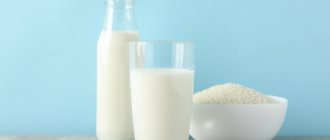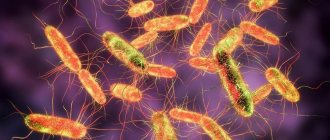Lactase deficiency in children is a type of malabsorption syndrome that develops due to intolerance to the disaccharide lactose (milk sugar). In babies in the first year of life, its signs are detected very often, but proper treatment helps get rid of the pathology.
Lactase deficiency - main types and characteristics
What lactase deficiency is is not difficult to understand. To digest lactose, the human body produces an enzyme called lactase. When there is a shortage of it, the same condition occurs when the baby’s gastrointestinal tract is unable to process dairy products.
Lactase deficiency can be primary or secondary.
The primary type is rare and presents with the most severe symptoms. This is a genetic pathology in which lactase synthesis is impaired or does not occur at all.
Secondary deficiency is much more common. Its signs are less obvious, sometimes smoothed out and go away on their own with age. Due to the immaturity of the enzyme system, it is observed in most premature babies. Also reasons may be:
- taking antibiotics;
- parasitosis;
- intestinal infections.
Among other things, symptoms of this type of lactase deficiency appear when you are allergic to milk. In some cases, lactase deficiency persists even into adulthood.
Perthes disease occurs in children at an early age or closer to puberty. It covers the hip joint, requires long-term conservative therapy, and sometimes children need surgery. Read more in the article: “Perthes disease in children: symptoms and treatment.”
Tests and diagnostics
To detect lactase deficiency, quantitative analyzes of the carbohydrate content in stool samples are performed. For children under one year old, this figure is normally no more than 0.25%. At the same time, deviations in the case of pathology are insignificant and range from 0.3-0.5%, but on average they are 0.6-1.0% or more. Usually, carbohydrates are not detected in the feces of infants, since enzymatic processes have not reached their development and the microbial biofilm has not yet been formed, and it is this that must take over most of the enzymatic processes in the intestines. The examination also takes into account medical history, complaints and genealogical information.
In addition, in older patients, hydrogen breath tests to detect excess colonization of the small intestine, determination of disaccharidase activity during endoscopy, and lactose loading tests are prescribed.
Symptoms in children under one year of age
Usually, parents begin to notice strange signs in their child’s digestion at the age of 3-6 months. The main symptom is the appearance of loose, foamy stools that have an unpleasant sour odor. Usually, this type of bowel movement occurs soon after drinking the mother's breast milk. In severe cases, even after a single feeding in the morning, stool disorders are present all day.
Other important signs of a problem:
- bloating before bowel movements;
- abdominal hardness;
- abdominal pain - intestinal colic;
- strong seething, audible even without applying the ear.
Colic in an infant can become literally debilitating, occurring at night and during the day. The baby screams, because the pain from distension of the colon against the background of gas formation is quite strong. Painful spasms are also observed, during such periods the child may “roll away” from pain. The process of excreting feces is also difficult - the child cries, but after emptying he feels some relief.
The Coxsackie virus is considered exotic by many. However, you can become infected with it even without traveling to warm countries, but with proper treatment, recovery will be quick. Read more in the article: “what to apply to a rash with coxsackie.”
Diet of a nursing mother
A mother's diet for lactose intolerance in infants involves limiting or completely abstaining from drinking whole milk. In this case, the daily diet should contain a fermented milk product, hard cheese or butter, since they serve as a source of calcium and vitamins. A woman should exclude cow's milk from her diet, since the protein it contains can be irritating to the child's body. If after this correction the child no longer shows signs of intestinal irritation, it means that the condition was not caused by lactase deficiency, but by an allergy to protein.
A woman who is lactating must exclude foods and dishes containing sugar from the menu. Optimal nutrition - vegetables, rice, eggs, nuts, corn, lean meats and fish.
What else indicates illness in children?
The so-called fermentative diarrhea in babies with lactase deficiency can occur 10-12 times a day. Often there are streaks of blood and mucus in the stool - this means damage to the intestinal mucosa or the development of an inflammatory process.
In a child 9-12 months old, undigested food particles can be visually seen in the stool.
In some children, the picture is different - diarrhea alternates with constipation due to impaired enzyme production. There are other symptoms that complement the clinical picture:
- regurgitation - vomiting small amounts of undigested food after eating;
- aching abdominal pain due to intestinal irritation even when not eating;
- poor sleep, long time to fall asleep, early awakening;
- sleeping with your legs tucked in to reduce pain;
- moodiness, constant crying;
- poor weight gain, weight loss.
All of these signs often force a mother to give up breastfeeding. Prolonged absence of treatment for the pathology causes serious problems with the child’s health. He may lag behind in development (physical, mental). If you continue to feed your baby incorrectly, severe dysbiosis develops, convulsions, rickets, and deficiency of vitamins and minerals may appear.
Lactase deficiency in infants: treatment
If we are really talking about lactase deficiency in an infant, the symptoms of which clearly indicate pathology, contact your pediatrician. Most likely, he will first recommend changing your breastfeeding system.
How to do it:
- Do not pump after finishing a feeding because each time you pump, your baby will often get milk that is very high in lactose.
- If the breast remains full after feeding, offer the same breast at the next feeding;
- Do not offer the second breast at one feeding until the baby has completely sucked milk from the first. Otherwise, he will exclusively suck the “front” milk from both glands, and he will never get the “back” milk.
- With long breaks in feeding, the milk is more stratified into “front” and “back”, so try to feed more often, do not take long breaks and feed at night;
- Make sure your baby attaches correctly to the nipple;
- Do not remove the breast from a sucking baby before he is satisfied.
Diagnosis and treatment basics
It is possible to identify the problem by eye, but it is difficult to diagnose its type and severity on your own. You should contact a pediatric gastroenterologist and conduct an examination and take tests. Diagnostics may include the following methods:
| Method | How is it carried out? | What does it show |
| Diet diagnostics | Mother's milk and infant formulas are excluded, only lactose-free formulas are given | When symptoms disappear, a diagnosis is made |
| Stool analysis | The amount of sugar and acidity levels are studied | The diagnosis is confirmed when the pH is less than 5.5 and sugar is more than 0.25% |
| Hydrogen test | The proportion of hydrogen in exhaled air is determined | If there is an excess amount of carbohydrates in the gastrointestinal tract, the hydrogen norm will be exceeded |
| Small bowel biopsy | A biopsy sample is taken from the small intestine under general anesthesia. | Congenital lactase deficiency is confirmed or refuted |
Also, the primary type of pathology is determined during genetic analysis - lactase genotyping.
In case of congenital pathology, it is necessary to completely and for life exclude any dairy products from the baby’s diet. In all other cases, they try to limit them without completely eliminating them, using a special diet and medications.
Hidden lactase
ATTENTION!
To improve the structure, taste and other properties, lactose is often used in the manufacture of food products. It is “hidden” in dry milk formulas, bread, frozen vegetables, canned soups, dressings and sauces, spaghetti, sausage, jam, sweets, instant foods, fast food, ketchup, mayonnaise, chocolate (except bitter). Read the product ingredients!
Milk sugar (lactose) is an auxiliary component of many drugs, for example, Ganaton, Gastal, Motilium, Cerucal, Imodium, Karsil, Linex, No-shpa, Kvamatela, Dulcolax, Gelusil, Galstena, Wobenzym, Mexidol, Corvalol, Warfarin, Bilobil, Panzinorm -forte, Omeza, and other drugs. Read the annotations for medications! Considering that lactase deficiency is based on a deficiency of the small intestinal enzyme - lactase, there are currently drugs that perform a replacement function for the lack of this enzyme. Dietary supplements Lactase, Lactazar can be taken 1 capsule along with a dairy product and help digest milk sugar, Tylactase taken 1 capsule with food or 2 capsules added per 1 liter of milk, store in the refrigerator, Lactrase 1-2 capsules before taking dairy products.
Forecast. If lactase deficiency is congenital, elimination diets are beneficial. In acquired variants of lactase deficiency, the course of the underlying disease that caused this type of enteropathy is important.
All about therapeutic nutrition
How much milk sugar can be left in the diet depends on the biochemical analysis of the stool. Complete exclusion of lactose is carried out in the most severe cases and only as a temporary measure. Lactase is a natural probiotic, and without it it will be extremely difficult for a child to live.
For breastfed babies, special dietary supplements are added to mother's milk.
Mom's diet should not contain such foods - whole milk, beef, allergens and large amounts of sugar.
For children who consume formula milk, a lactose-free complex is selected (in monotherapy or in combination with a regular formula). The child’s reaction is tested experimentally; sometimes you have to try several different mixtures. A number of patients tolerate goat milk formulas well. Typically, gastroenterologists prescribe low-lactose mixtures:
- Nutrilon;
- Nutrilak;
- Humana LP+SCT.
Completely lactose-free mixtures are produced by the brands Nan, Mamex, Nutrilak, Friso. When the milk of a nursing mother is no longer enough for the baby (from 3-5 months), complementary foods are introduced. It starts with zucchini and other vegetables, and is introduced 1 item at a time over 3-4 days. Within 2 weeks, the amount of vegetables per day reaches 150 g. Next, rice, corn, buckwheat, and then meat are introduced. By 9 months they try kefir, yogurt and other fermented milk products, and cottage cheese only after a year.
Signs of lactose intolerance in infants:
- frequent foamy, loose stools up to 8-10 times with a large water spot (lactose prevents water from being absorbed, which leads to diarrhea);
- sour smell of stool (the process of fermentation of microflora in the intestines starts);
- colic due to gas formation;
- in severe cases, dehydration accompanied by severe diarrhea;
- malnutrition, when, with severe degrees of lactase deficiency, nutrients are not absorbed.
— What tests need to be done to determine lactose and lactase intolerance/insufficiency?
— The gold standard for diagnosis is coprogram. The disease is confirmed by the presence of carbohydrates in the feces (more than 0.25% in children under 1 year of age) and an acidic reaction of the feces (pH less than 5.5). There are no other specific signs for transient lactase deficiency. In case of secondary lactase deficiency, depending on the clinical symptoms, a number of tests are done to confirm the presence of the causative disease.
— Valeria Maksimovna, what to do if a child has lactose intolerance to breast milk?
— In addition to therapy aimed at the underlying disease, if present, symptomatic therapy should be prescribed.
- With colic,
it is necessary to ease the situation for the child and make sure that the gases move through the intestines and come out. Abdominal massage, heat on the tummy, a gas tube, special positions for sleeping or on the stomach, cocoons for newborns, and simethicone-based products will help. - Child's refusal to eat.
Loss of appetite is often associated with pain due to swollen intestinal walls - the child may develop a negative association with feeding, after which abdominal problems begin. - Digestive disorders
- colic, problems with stool, regurgitation. In case of transient lactase deficiency, replacement therapy is carried out. - Allergy to cow's milk proteins.
A breastfeeding mother is prescribed a dairy-free diet, and a bottle-fed baby is prescribed therapeutic nutrition. In case of acute allergies, self-treatment is unacceptable; you need to urgently go to the doctor.
Drugs to treat the disease
The main drugs for this pathology are enzymes. Enzyme replacement therapy is carried out under the guidance of a doctor to select the correct dose. The following medications are prescribed:
- Laktazar
(340 rubles) - contains 700 units of lactase, one capsule is added to 100 ml of breast milk, formula; - Lactase Baby
(580 rubles) - one capsule is dissolved in warm milk (100 ml), given to the child after 2-3 minutes; - Baby doc lactase
- comes in drops, use 10 drops per 3 tablespoons of milk, then breastfeed.
After introducing complementary foods, the child may need pancreatic enzymes (Creon, Festal), probiotics for the intestines (Hilak Forte, Linex). For severe bloating, they give the baby Espumisan-baby, Bobotik. Typically, improvement from therapy is observed by 3-4 days. In most children, lactase deficiency goes away by the age of one year.
Lactase deficiency: origin and ways of correction
The problem of lactase deficiency (LD) and lactose intolerance (as a clinical manifestation of LN) is as old as the world in the most literal sense of this expression. Lactose intolerance was first described by Hippocrates, approximately 400 BC, but understanding of the mechanisms of its development came only in the middle of the 20th century [1]. LN is associated with a decrease in the activity of the lactase enzyme of the brush border of enterocytes of the small intestine, which breaks down the milk sugar lactose. Traditionally, LI is divided into congenital, manifested from birth and caused by a mutation in the LCT gene on chromosome 21, primary (adult-type LI), associated with a genetically determined decrease in lactase activity after cessation of milk feeding, secondary, associated with damage to enterocytes in intestinal diseases, and transient LI of premature and immature children at the time of birth. The greatest importance, of course, is lactose intolerance in children in the first months of life, for whom human milk or infant formula are the only possible food products. At the same time, the most common and most attention-grabbing option is primary LN.
Humanity has been consuming milk and dairy products for thousands of years, which has led to the formation of a powerful dairy industry. In the world, cow's milk production dominates over the milk production of other ruminants, amounting to approximately 85%, followed by buffalo milk - about 11%, and goat and sheep milk - 2.4% and 1.4%, respectively. The share of cow's milk production is lower in the southern regions compared to the northern regions, and 80% of the world's goat's milk production is produced in the tropics. At the same time, in recent years, cow's milk production in developed countries has been decreasing, but increasing in developing countries. Particularly noteworthy is the large contribution to the production of cow's milk from India, a country in which a significant part of the population has adult-type LD (Table 1) [2, 3, 5].
The importance of milk consumption is primarily determined by the fact that milk is an important and accessible source of calcium. From the chart below, you can see that most of the calcium consumed is of animal origin. At the same time, in countries with low milk consumption, low calcium consumption is also observed. In this regard, correction of LI is a necessary factor in ensuring health, and when milk and dairy products are excluded from the diet of a child and an adult, it is necessary to compensate for the resulting calcium deficiency. Persons who limit the consumption of milk and dairy products for one reason or another should compensate for the resulting calcium deficiency from other sources, and it is hardly possible to solve this problem without prescribing medications (Fig.) [5].
There is also interesting data on the possible preventive effect of dairy products in relation to a number of cancers, in particular colon cancer, breast cancer, stomach cancer, as well as in relation to inflammatory bowel diseases, obesity and type 2 diabetes mellitus, however, this topic requires further in-depth study [6].
Lactose intolerance, a decrease in lactase activity after cessation of milk feeding, is a normal condition for all mammals, and only some representatives of Homo sapiens retained this ability throughout subsequent life.
Man first began to use ruminants in his economic activities in Mesopotamia between the 11th and 9th millennia BC. These were cows (Bos primigenius taurus), goats (Capra aegagrus hircus) and sheep (Ovis orientalis aries). At the same time, buffaloes (Bubalus bubalis) became domestic animals in India and China around 5000–7000 BC, and yaks (Bos grunniens) became domesticated animals in Tibet around 4500 BC. Domestic ruminants were already used in those years not only as a source of meat, but also milk and wool. Archaeological research has discovered the stomachs of these animals, in which milk was stored, which was processed into cheese under the influence of a residual amount of renin, a gastric enzyme. Cheese has been made from milk since at least 6500 BC. Sumerian cuneiform sources from the Third Dynasty of Ur (ca. 2000 BC) indicate the consumption of cheese, and cheese was produced in Egypt and Crete during the same period. In Ancient Rome, cheese was a common food product [7, 9]. Initially, the genotype of humans (like all mammals) included a decrease in lactase activity after the end of the breastfeeding period. Genetic studies have shown that mutations associated with lactose tolerance appeared around 10,000 BC, paralleling the domestication of ruminants [11]. The so-called "cultural-historical hypothesis" suggests that the continued high lactase activity of northern Europeans resulted from a selection process that allowed the population to rely on mammalian milk as an important component of the diet, especially in lean years. The opposite hypothesis defines a reverse cause-and-effect relationship, suggesting that widespread milk consumption led to the consolidation of lactose tolerance in the population, but this hypothesis seems less probable based on archaeological research [12–15].
In addition to being a source of energy and water, drinking milk provided a person with an effective source of calcium, providing higher bone density and preventing rickets [17]. This was more relevant for the northern regions (in particular, Northern Europe) in conditions of low insolation and a higher need for calcium with vitamin D deficiency. Accordingly, a higher frequency of lactose tolerance is observed in the northern regions of Europe, and intolerance - in the southern regions [5, 17, 19, 20]. Interestingly, lactose tolerance is associated with resistance to malaria, a phenomenon studied primarily in the Fulani people of Africa, but the mechanisms behind this relationship remain unknown [21].
The LCT gene, which encodes lactase and determines the breakdown and, therefore, tolerance of lactose, has a length of 49.3 kb, is located on the long arm (q) of chromosome 2 at position 21 and contains 17 exons (NCBI Reference Sequence NG_008104.1) [23] . For primary LN, a genetic polymorphism has been described affecting the replication factor MCM6, one of the highly conserved proteins of the MCM group required for the initiation of replication in eukaryotic cells (primarily the LCT-13910C.T polymorphism in intron 13 and LCT-22018G.A in intron 9 of the MCM6 gene ) [25–27]. The LCT-13910CT and LCT-13910TT genotypes are associated with lactose tolerance and, being present in one allele in a heterozygous state, have a dominant effect, ensuring the breakdown of lactose, while the LCT-13910CC genotype in the absence of the LCT-13910T allele leads to lactose malabsorption [26 , 27]. There is parallelism between the genotypes LCT-13910C.T and LCT-22018G.A. Individuals with the LCT-13910CC genotype have the LCT-22018GG variant, while those with LCT-13910CT often have LCT-22018GA, with LCT-13910TT associated with LCT-22018AA, with the exception of a small number of observations in Finland [27], China [28] and in Brazilians of Japanese descent [29]. These lactose malabsorption genotypes are widespread in Europe, while other lactose tolerance/intolerance alleles are present in other regions of the world [30].
In Europe, the prevalence of primary FN varies from 2% in Scandinavia to 70% in some regions of Italy [31]. Its prevalence in the white population of the United States is 20%; in Asia it is close to 100%. The prevalence of FN in adults in Sweden, Denmark is about 3%, Finland, Switzerland - 16%, England - 20-30%, France - 42%, Southeast Asian countries, among African Americans in the USA - 80-100%, European Russia - 16–18%. However, not all people with LI require correction.
Only those patients with LI who have clinical manifestations require treatment. Deviations from the norm in the results of diagnostic methods, which are not accompanied by corresponding symptoms, are also not grounds for therapy.
In case of congenital and primary LI, the patient’s treatment is based on reducing the amount of lactose in the diet, up to its complete elimination. In parallel with this, therapy is carried out aimed at correcting intestinal dysbiosis and other symptomatic treatment.
In case of secondary LN, the main attention should be paid to the treatment of the underlying disease, and reducing the amount of lactose in the diet is a temporary measure that is carried out until the mucous membrane of the small intestine is restored.
Reducing the amount of lactose in the diet can be achieved by eliminating lactose-containing products, primarily whole milk, from the diet.
This method is quite acceptable for adults and older children with adult-type LI and secondary LI. In this case, the consumption of fermented milk products, butter, and hard cheeses is often allowed. The possible reduction in calcium intake with a dairy-free diet should be considered.
In infancy, if the child is breastfed, the optimal approach is to use lactase preparations, which are mixed with expressed breast milk and break down lactose without affecting its other properties. Lactase producers for the production of corresponding drugs and dietary supplements (and in most cases, products containing lactase are registered as dietary supplements) are yeast, most often Kluyveromyces fragilis, Kluyveromyces lactis or molds Aspergillus niger and Aspergillus oryzae.
Children who are bottle-fed should be switched to full or partial nutrition with low-lactose (lactose-free) breast milk substitutes, choosing a diet with the maximum amount of lactose that does not cause the appearance of clinical symptoms and an increase in the content of carbohydrates in the feces.
The diet is supplemented by symptomatic therapy, which depends on the child’s condition and the severity of secondary disorders. If exicosis develops, therapy aimed at correcting the water and electrolyte balance is required. Also, the development of intestinal dysbiosis can determine the indications for the use of probiotics.
In the future, after symptoms have stopped in children with LI, it is necessary to monitor the carbohydrate content in feces over time and, when symptoms return, reduce the amount of lactose.
In breastfed children in the absence of lactase drugs, similar tactics are used.
Complementary feeding dishes (porridge, vegetable purees) for children of the first year of life with LI, naturally, should not contain lactose. The calendar for introducing complementary foods does not differ from that for children without disabilities.
In children over one year of age and adults with LI, products containing lactose are excluded from the diet (Table 2). It is advisable to replace milk and dairy products with specialized low-lactose dairy products: low-lactose milk, cream, sour cream, etc. in quantities determined by age-related needs. These patients usually tolerate fermented milk products (kefir, yogurt) well.
The problem of moderate lactase deficiency can be solved by consuming fermented milk products with low lactose content, due to the release of β-galactosidase into the gastrointestinal tract by live probiotic bacteria that can survive in the gastrointestinal tract [18]. Unique in this regard among other fermented milk products is yogurt, like buttermilk or sweet acidophilus. They are well tolerated by people with lactase deficiency and promote the breakdown of lactose thanks to the bacteria Lactobacillus bulgaricus and Streptococcus thermophilus [18, 24], which release β-galactosidase in the intestine. The administration of probiotics improves the enzymatic activity of intestinal microorganisms, increases the digestion of lactose, reduces the symptoms of lactase deficiency, slowing down the transit of contents through the digestive tract. Pasteurization of fermented milk products reduces the number of living bacteria [18, 24]. A clinical study of capsules containing Bifidobacterium longum and yoghurt fortified with Bifidobacterium animalis proved effective in relieving symptoms of lactose intolerance [10]. A similar study in children (ages 5 to 16 years) found that consuming milk with Lactobacillus acidophilus or yogurt containing Lactobacillus lactis and Streptococcus thermophilus reduced symptoms of lactase deficiency, compared with a group of children consuming unfortified milk [18]. It is known that by fermenting lactose with lactic acid microorganisms, it is possible to utilize up to 20% of lactose as much as possible (up to 4% of residual lactose), which is ineffective from the point of view of lactase deficiency. The possibility of producing low-lactose fermented milk products using the enzyme preparation β-galactosidase obtained from the yeast Kluveromyces lactis was studied. The rate of fermentation of milk hydrolyzed with β-galactosidase was studied, both before the introduction of the starter and simultaneously with its introduction. In one case, the starter was added to pre-hydrolyzed milk (the fermentation process was combined with the reserve process; in the other, the starter was added directly with the β-galactosidase enzyme (0.2%, concentration 2000 NEL/g). Reducing the ripening process and increasing the water-holding capacity in samples with the simultaneous addition of enzyme and starter can be explained by the fact that the products of enzymatic catalysis activate the starter microflora. The content of residual lactose in control samples (without enzyme) was 4.0–3.8%; in test samples with preliminary hydrolysis of lactose 1.2– 1.0%; in samples with simultaneous addition of enzyme and starter – 1.0–0.8% [34, 37].
It should be noted that lactose has become widely used in the food and pharmaceutical industries in recent decades. It is used as a sweetener and as a foaming agent, gives products a pleasant taste and forms an attractive texture in the production of baked goods, drinks (both non-alcoholic and alcoholic, in particular beer), meat products (for example, in the production of burgers), etc. Important that lactose is not fermented by mushrooms, and this avoids excess production of carbon dioxide and alcohols. Lactose can be present in processed meats (sausages, pates, etc.), margarine, bread, potato chips, sauces, processed cheeses, protein supplements, and beer. In the pharmaceutical industry, lactose is widely used as a filler in pharmaceuticals. In this regard, the volume of industrial production of lactose is growing year by year [5, 32, 33, 35]. Accordingly, the list of lactose-containing non-dairy products is also expanding.
The duration of therapy is determined by the nature of the disease. In case of congenital LI, a low-lactose diet is prescribed for life. With transient LI of prematurity, many children gradually regain the ability to tolerate lactose over several months (although this does not exclude the development of primary LI). Canceling the diet is carried out under individual monitoring of lactose tolerance.
With secondary hypolactasia, symptoms of FN are transient. Patients are treated for the underlying disease; Along with this, a low-lactose diet is prescribed in accordance with the principles outlined above. When the normal structure and function of the small intestinal mucosa are restored, lactase activity is restored. Therefore, when the underlying disease resolves (remission) after 1–3 months, the diet can be gradually expanded, although even here a strictly individual approach is required [36].
Taking into account the intestinal dysbiosis that develops in clinically manifest LI, it is advisable in this situation to prescribe probiotics. They can be prescribed as stand-alone medications, but some manufacturers include them in formulas for artificial feeding.
Maxilak® and Maxilak Baby do not contain casein (milk protein) and lactose (milk sugar), they are hypoallergenic and can be used even with high allergic sensitivity. Maxilak® and Maxilak® Baby contain bifidobacteria and lactobacilli of various strains and can be used to maintain endogenous flora in case of secondary lactase deficiency.
Maxilak® is available in two forms:
- Sachet Maxilac® Baby from 4 months of age (Lactobacillus acidophilus LA-14 - 1.11 × 108 CFU; Lactobacillus casei CBT (1) - 1.11 × 108 CFU; Bifidobacterium lactis BL-04 - 1.11 × 108 CFU; Lactobacillus paracasei Lpc-37 - 1.11 × 108 CFU, Lactobacillus plantarum Lp-115 - 1.11 × 108 CFU, Lactobacillus rhamnosus GG - 1.11 × 108 CFU, Lactobacillus salivarius Ls-33 - 1.11 × 108 CFU; Bifidobacterium bifidum BF-2 - 1.11 × 108 CFU; Bifidobacterium longum BG-7 - 1.11 × 108 CFU);
- • Maxilak®, capsules for children over 3 years of age and adults, including pregnant women (Lactobacillus helveticus - 9.00 × 108 CFU; Lactococcus lactis - 9.00 × 108 CFU; Bifidobacterium longum - 6.75 × 108 CFU; Bifidobacterium breve - 4.50 × 108 CFU; Streptococcus thermophilus - 4.50 × 108 CFU; Lactobacillus rhamnosus - 4.50 × 108 CFU; Lactobacillus casei - 2.25 × 108 CFU; Lactobacillus plantarum - 2.25 × 108 CFU; Bifidobacterium bifid um — 2.25 × 108 CFU).
In addition to the release form (capsules and sachets), Maxilak® and Maxilak® Baby differ from each other in the dosage of active ingredients. Thus, one Maxilac® capsule contains 4.5 billion CFU (colony-forming units of bacteria), and one Maxilac® Baby sachet (sachet) contains 1 billion CFU. All strains included in Maxilak® and Maxilak® Baby are of original origin and are included in the list of European quality, which proves a high level of safety. Studies of the acid resistance of Maxilak® probiotic strains at pH = 2 for two hours demonstrated high viability. C. Chapman et al. [4] proved that, unlike individual strains, multistrain probiotics are characterized by higher antimicrobial activity (p < 0.05). Unlike modified starch, pectin and other fibers, oligofructose selectively stimulates the growth and metabolic activity of certain types of bacteria (bifidobacteria and lactobacilli), without affecting the growth of other groups of bacteria (fusobacteria, bacteroides, etc.), and inhibits the growth of potentially pathogenic bacteria (Clostridium perfringens, Clostridium his/lyt, Enterococci groups), oligofructose also increases the protective effects of bifidobacteria. In the production of Maxilak®, a unique capsule protection technology MURE® (Multi Resistant Encapsulation) is used - the capsule is covered with a shell that protects its contents and preserves the viability of bacteria even when exposed to aggressive factors of the external and internal environment, therefore the bacteria present in Maxilak® are protected from the acidic contents gastric juice, bile salts and digestive enzymes. The theoretical premises underlying the developed synbiotic provide for the correction of disturbed intestinal microflora, which usually arise as a result of acute infections, the course of chronic diseases, the use of antibacterial drugs, imbalances in the functioning of organs and systems of the macroorganism, including lactase deficiency.
To summarize, we can conclude that primary LI is a widespread individual feature that in most cases does not require medical intervention. LN should be called a disease only in case of obvious clinical manifestations. Of course, the problem becomes most important in children in the first months of life, for whom milk is the main food product. As for older children and adults, it should be borne in mind that the absence of dairy products in the diet can lead to calcium deficiency in the body, and therefore drug correction of this condition is necessary.
Literature
- Beja-Pereira A., Luikart G., England PR et al. Gene-culture coevolution between cattle milk protein genes and human lactase genes // Nat Genet. 2003; 35: 311–313.
- Boll W., Wagner P., Mantei N. Structure of the chromosomal gene and cDNAs coding for lactase-phlorizin hydrolase in humans with adult-type hypolactasia or persistence of lactase // Am J Hum Genet. 1991; 48:889–890.
- Cavalli-Sforza LL Analytic review: some current problems of human population genetics // Am J Hum Genet. 1973; 25:82–104.
- Chapman TM, Plosker GL, Figgitt DP VSL#3 probiotic mixture: a review of its use in chronic inflammatory bowel diseases // Drugs. 2006; 66(10):1371–1287.
- Coelho M., Luiselli D., Bertorelle G. et al. Microsatellite variation and evolution of human lactase persistence // Hum Genet. 2005; 117:329–339.
- Enattah NS, Sahi T., Savilahti E., Terwilliger JD, Peltonen L., Jãverlã I. Identification of a variant associated with adult-type hypolactasia // Nat Genet. 2002; 30: 233–237.
- Evershed RP, Payne S, Sherratt AG, Copley MS, Coolidge J, Urem-Kotsu D, Kotsakis K, Ozdogan M, Ozdogan AE, Nieuwenhuyse O et al. Earliest date for milk use in the Near East and southeastern Europe linked to cattle herding // Nature. 2008, 455, 528–531.
- Gerosa J., Skoet J. Milk Availability: Trends in Production and Demand and Medium-Term Outlook. Available online: www.fao.org/docrep/015/an450 e/an450 e00.pdf (accessed on 26 May 2015). ESA Working paper no. 12–01 February 2012.
- Global Consumption of Dairy Products. Canadian Dairy Information Centre. Available online: https://www.dairyinfo.gc.ca/index_e.php?s1=dff-fcil&s2=cons&s3=consglo (accessed on May 26, 2015).
- He T, Priebe MG, Zhong Y, Huang C, Harmsen HJ et al. Effects of yogurt and bifidobacteria supplementation on the colonic microbiota in lactose-intolerant subjects // J Appl Microbiol. 2008, 104: 595–604.
- International Dairy Federation (IDF). World Dairy Situation 2014; Bulletin No. 476/2014; IDF: Brussels, Belgium, 2014.
- Kretchmer N. Lactose and lactase // Sci Am. 1972; 227:71–78.
- Leonardi M., Gerbault P., Thomas MG, Burger J. The evolution of lactase persistence in Europe. A synthesis of archaeological and genetic breastfeeding evidence // Int. Dairy J. 2012, 22, 88–97.
- Lokki AI, Järvelä I., Israelsson E., Maiga B., Troye-Blomberg M., Dolo A., Doumbo OK, Meri S., Holmberg V. Lactase persistence genotypes and malaria susceptibility in Fulani of Mali // Malar J. 2011, Jan 14; 10:9.
- Lomer MC, Parkes GC, Sanderson JD Review article: lactose intolerance in clinical practice - myths and realities // Aliment Pharmacol Ther. 2008, Jan 15; 27 (2): 93–103.
- Malmström H., Linderholm A., Lidén K., Storå J., Molnar P., Holmlund G., Jakobsson M., Götherström A. High frequency of lactose intolerance in a prehistoric hunter-gatherer population in northern Europe // BMC Evol . Biol. 2010, 10, 89, I.
- Mattar R., Monteiro MS, Silva JMK, Carrilho FJ LCT-22018 GA single nucleotide polymorphism is a better predictor of adult-type hypolactasia/lactase persistence in Japanese-Brazilians than LCT-13910 CT // Clinics (São Paulo). 2010; 65:1399–1400.
- Montes RG, Bayless TM, Saavedra JM, Perman JA Effect of milks inoculated with Lactobacillus acidophilus or a yogurt starter culture in lactose-maldigesting children // J Dairy Sci. 1995, 78: 1657–1664.
- Nei M., Saitou N. Genetic relationship of human populations and ethnic differences in reaction to drugs and food // Prog Clin Biol Res. 1986; 214:21–37.
- Ozdemir O., Mete E., Catal F., Ozol D. Food intolerances and eosinophilic esophagitis in childhood // Dig Dis Sci. 2009; 54:8–14.
- Ranciaro A., Campbell MC, Hirbo JB, Ko W.-Y., Froment A., Anagnostou P., Kotze MJ, Ibrahim M., Nyambo T., Omar SA et al. Genetic origins of lactase persistence and the spread of pastoralism in Africa // Am. J.Hum. Genet. 2014, 94, 496–510.
- Rasinperä H., Savilahti E., Enattah NS et al. A genetic test which can be used to diagnose adult-type hypolactasia in children // Gut. 2004; 53:1571–1576.
- Salque M., Bogucki PI, Pyzel J., Sobkowiak-Tabaka I., Grygiel R., Szmyt M., Evershed RP Earliest evidence for cheese making in the sixth millennium BC in northern Europe // Nature. 2013, 493, 522–525.
- Savaiano DA, Abou El Anouar A., Smith DE, Levitt MD Lactose malabsorption from yogurt, pasteurized yogurt, sweet acidophilus milk, and cultured milk in lactase-deficient individuals // Am J Clin Nutr. 1984, 40: 1219–1223.
- Sherratt A. The secondary exploitation of animals in the Old World // World Archaeol. 1983, 15, 90–104.
- Silanikove N., Leitner G., Merin U., Prosser CG Recent advances in exploiting goat's milk: Quality, safety and production aspects // Small Ruminant Res. 2010, 89, 110–124.
- Simoons FJ Primary adult lactose intolerance and the milking habit: a problem in biology and cultural interrelations: II. A cultural historical hypothesis // Am J Dig Dis. 1970; 15: 695–710.
- Szilagyi A. Adaptation to Lactose in Lactase Non-Persistent People: Effects on Intolerance and the Relationship between Dairy Food Consumption and Evaluation of Diseases // Nutrients. 2015 Aug 13; 7(8):6751–6779.
- Troelsen JT Adult-type hypolactasia and regulation of lactase expression // Biochim Biophys Acta. 2005; 1723: 19–32.
- US Food and Drug Administration - Problems Digesting Dairy Products? Available online: https://www.fda.gov/forconsumers/consumerupdates/ucm094550.htm#intolerance (accessed on May 26, 2015).
- Xu L., Sun H., Zhang X. et al. The –22018 A allele matches the lactase persistence phenotype in northern Chinese populations // Scand J Gastroenterol. 2010; 45: 168–174.
- Zecca L., Mesonero JE, Stutz A. et al. Intestinal lactase-phlorizin hydrolase (LPH): the two catalytic sites; the role of the pancreas in pro-LPH maturation // FEBS Lett. 1998; 435:225–228.
- Zecca L., Mesonero JE, Stutz A. et al. Intestinal lactase-phlorizin hydrolase (LPH): the two catalytic sites; the role of the pancreas in pro-LPH maturation // FEBS Lett. 1998; 435:225–228.
- Danilov M. B. Activity of β-galactosidase of microorganisms used in the production of dairy products // Storage and processing of agricultural raw materials. 2001. No. 7. pp. 30–31.
- Mngram CJ, Liebert A., Swallow DM Population Genetics of Lactase Persistence and Lactose Intolerance; John Wiley & Sons, Inc.: Hoboken, NJ, USA, 2012.
- Mukhina Yu. G., Chubarova A. I., Geraskina V. P., Belmer S. V., Gasilina T. V., Borovik T. E., Roslavtseva E. A., Skvortsova V. A., Yatsyk G. V. Working protocol for the diagnosis and treatment of lactase deficiency in children // Issues. det. diets 2016; 14(1):64–69.
- Ripelius K., Dvinsky B. M. Maxilact - enzyme treatment of milk solves the problem of lactose intolerance // Dairy industry. 1995. No. 5. pp. 23–24.
S. V. Belmer, Doctor of Medical Sciences, Professor
Federal State Budgetary Educational Institution of Russian National Research University named after. N. I. Pirogova, Moscow
Contact Information
Lactase deficiency: origin and ways of correction / S. V. Belmer
For citation: Attending physician No. 2/2018; Page numbers in the issue: 41-46 Tags: infancy, feeding, lactose, intolerance











